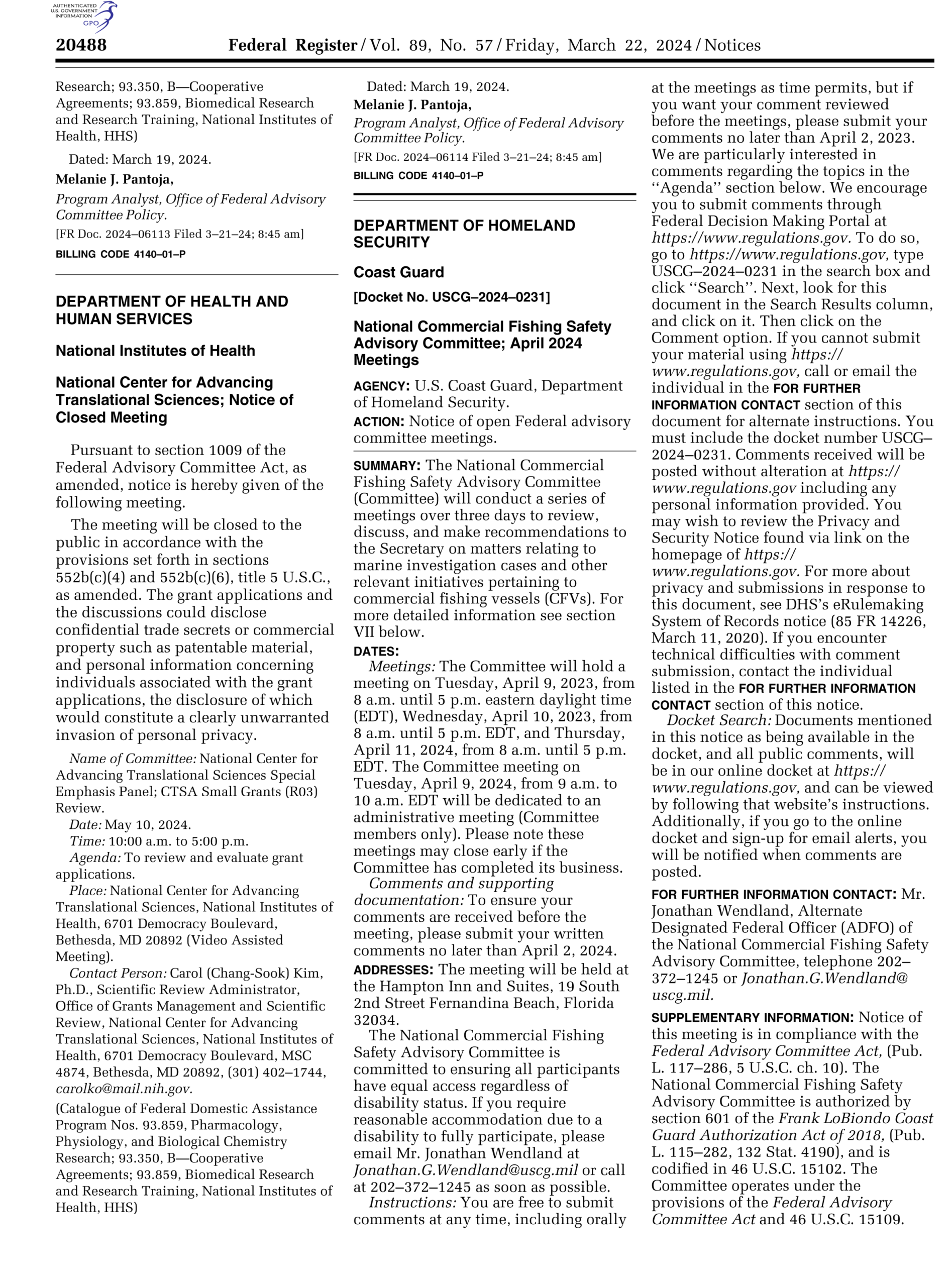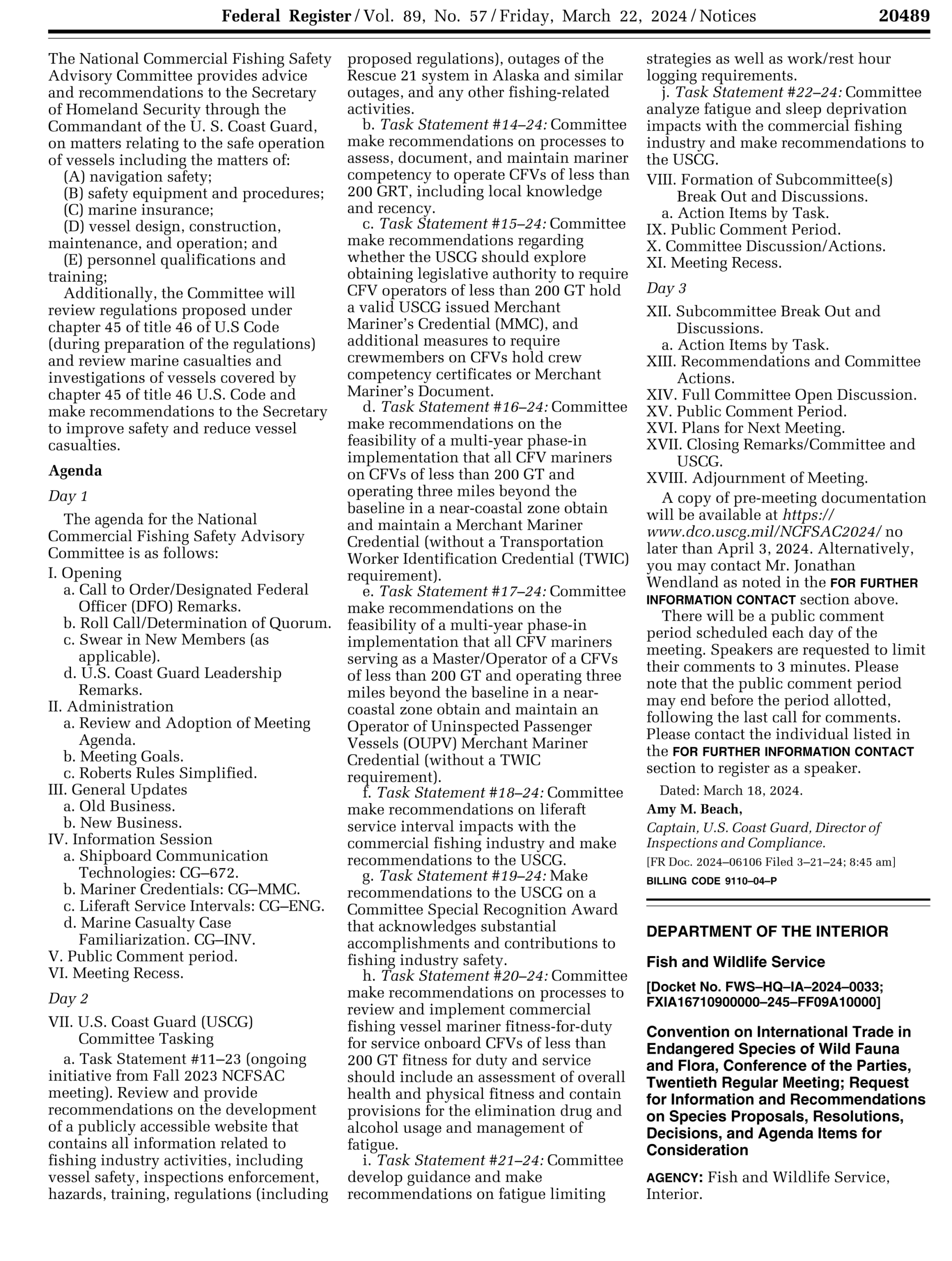

Category Archives: USCG
USCG REPORT OF INVESTIGATION – F/V MARY B II, YAQUINA BAY, OR
The Coast Guard has completed its investigation into the loss of the F/V MARY B II on the Yaquina Bay, Oregon Bar on January 8, 2019. The final Report of Investigation can be accessed at Marine Casualty Reports (uscg.mil). This was a tragic event with the loss of 3 fishermen.
YOU MAY NOT RECEIVE AIS BROADCASTS WHENEVER A VHF MARITIME RADIO IS KEYED
USCG Marine Safety Alert, February 20, 2024
A very high frequency (VHF) maritime radio transmission on one’s own vessel, or even transmissions by a nearby vessel a football field’s length away (about 136 meters or 445 feet), may block AIS reception for the duration the radio is keyed. An analysis of the relevant standards has shown that this may impact all classes of AIS equipment regardless of how the antennas for the two systems are installed. Antennas installed in conformance with the International Maritime Organization’s (IMO) COMSAR.1/Circ.32/Rev.2 Harmonization of GMDSS requirements for radio installations on board SOLAS ships, IMO SN.1/Circ 227, Guidelines for the installation of a shipborne automatic identification system (AIS), or the National Marine Electronics Association (NMEA) Installation Standard 0400 per 33 CFR 164.46(a), while helpful, will not avoid this blocking. It is important to note that this temporary disruption will not be readily apparent to AIS users nor noted on AIS displays.
As stated in IMO Resolution A.1106(29) Revised Guidelines for the Onboard Operational Use of Shipborne Automatic Identification Systems (AIS), users should not rely on AIS as the sole information system for collision avoidance or navigation decision-making, but should make use of all safety relevant information. Delayed updates to AIS positions and Aid to Navigation reports caused by keyed VHF radio transmitters, as well as possible loss of certain safety-related messages, are examples of why the AIS should not be solely relied upon for collision avoidance. Navigators are further reminded of Navigation Rule 7 – Risk of Collision, which states that “every vessel shall use all available means appropriate to the prevailing circumstances and conditions to determine if risk of collision exists” and that “assumptions shall not be made on the basis of scanty information,” such as AIS.
This Safety Alert is provided for informational purposes only and does not relieve any domestic or international safety, operational, or material requirement. Developed by the U.S. Coast Guard, Spectrum Management and Telecommunications Policy Division, in cooperation with the Radio Technical Commission for Maritime Services (RTCM). Distributed by the Office of Investigations and Casualty Analysis. Questions may be sent to HQS-SMB-CG-672@uscg.mil.
COAST GUARD RELEASES SCANDIES ROSE REPORT AND SUPPLEMENTAL DOCUMENTS
The Coast Guard report on the sinking of the SCANDIES ROSE was released yesterday along with supplemental information. This investigation was the highest-level Coast Guard Investigation, a Marine Board, so the Board took a lot of supplemental actions, including Ice Accretion tests and producing Safety Alerts. Please find links below to the report itself, the Findings of Concern, and the report on Ice Accretion on Crab Pots.
Link to report:
Link to Findings of Concern:
Link to REACT Ice Accretion Report:
MIKE RUDOLPH SELECTED AS NEXT USCG D13 CFVS COORDINATOR
 The Coast Guard has selected Mike Rudolph to replace Dan Hardin as the Thirteenth District Commercial Fishing Vessel Safety Coordinator. Mr. Rudolph brings 30 years of experience working with commercial fishermen in Alaska, Washington, and Oregon. His tours of duty have included Valdez and Anchorage, Alaska; Seattle, Washington; and, for the past 17 years, Portland, Oregon.
The Coast Guard has selected Mike Rudolph to replace Dan Hardin as the Thirteenth District Commercial Fishing Vessel Safety Coordinator. Mr. Rudolph brings 30 years of experience working with commercial fishermen in Alaska, Washington, and Oregon. His tours of duty have included Valdez and Anchorage, Alaska; Seattle, Washington; and, for the past 17 years, Portland, Oregon.
Mr. Rudolph is an Alaska Marine Safety Education Association (AMSEA) certified marine safety instructor and has trained over 2,000 fishermen as drill conductors. Most recently, he has taught courses in fishing vessel stability.
Continuing with Mr. Hardin’s legacy website (www.FishSafeWest.info) Mr. Rudolph will take over its management and updates. Mike comments, “The website is a tremendous resource. Not just for fishermen with its vessel checklist generator, but for fishing vessel safety professionals, too. It is one of my go-to resources when I am looking for a reference or the latest information.”
One of Mr. Rudolph’s main areas of focus will be to improve collaboration and partnerships between the Coast Guard and the fishing industry and other stakeholders. “That starts with this position being accessible, visible and engaged in the issues,” Mike said.
Mr. Hardin retired from the Coast Guard in August 2023 after 50 years of combined active duty and civilian service. He spent the past 22 years as the District Commercial Fishing Vessel Safety Coordinator. Mr. Rudolph takes over as the new District Coordinator in January 2024.
SHIPBOARD CRANE WIRE ROPE HAZARD MITIGATION
USCG Marine Safety Alert, December 5, 2023
A recent marine casualty involving a shipboard crane occurred while a 69-ton wind turbine nacelle was being offloaded. While hoisting, a wire rope parted, causing the load to fall eight feet to the deck, significantly damaging the vessel and resulting in a total loss of the cargo. Although no personnel casualties occurred, injury potential was high, as the load landed within three feet of workers. An investigation revealed corrosion, wear, and monotonic ductile overload of the wire rope caused the failure. Further, it was concluded the wire rope was still within its permitted service life but should have been replaced prior to the incident due to the corrosion and wear.
Cargo transfers using shipboard cranes are common and increase vessel capabilities to service ports with minimal shoreside infrastructure. Although crane wire rope failures are rare, the consequences are serious and can include vessel damage, cargo loss, injury, and death.
While not addressed in regulation or convention, servicing and discard criteria are outlined in class rules and manufacturer specifications. The industry standard period of employment is ten years, but suitability for service can be limited by corrosion and fatigue. Given the potential wear associated with harsh operating environments, it is imperative that vessel operators employ robust inspection and testing to ensure equipment suitability through its lifespan.
Multi-layered construction inhibits inner core inspection and maintenance, creating physical condition uncertainty. To address this hazard, some manufacturers recommend using pressure lubricating devices to inject lubricant into the inner core, providing corrosion protection and reducing friction. Heavy lubricating grease applied to the outer strands may conceal surface defects that, if identified, could result in removal from service. While inspections and maintenance are essential, the only way to verify safe loading capacity is through periodic load tests, which are typically completed every five years and after major repairs.
Owner-operators are reminded that, for those ships on international voyages and subject to the SOLAS Convention, recent amendments to SOLAS include new regulations and associated guidelines for onboard lifting appliances, including cranes. The regulations and guidelines include mandatory requirements for the design, installation, testing, periodic inspection and documentation of lifting appliances and loose gear utilized with the appliance. A requirement for all lifting appliances, whether for new installation or previously installed, is that the safe working load (SWL) be established and permanently marked on the appliance.
The Coast Guard strongly recommends that vessels equipped with shipboard cranes:
• Implement increased load testing frequency to verify wire rope integrity between class society mandated 5-year load tests.
• Are provided with and utilize pressure lubricating devices as recommended by the manufacturer for routine maintenance.
• Ensure maintenance tracking systems align with manufacturer’s recommended maintenance protocol, including the period of employment and renewal of wire ropes.
• Consider shortened periods of employment and early renewal of crane wire ropes to prevent corrosion and fatigue induced failures.
• Instruct and train all personnel to never position themselves under cargo suspended by any crane, even temporarily.
• Ensure all shipboard crane operators are properly trained and cognizant of industry best practices.
• Implement increased wire rope visual inspection frequency.
• Degrease and remove all lubricant prior to crane wire rope visual inspections to ensure surface defects are not concealed.
This Safety Alert is provided for informational purposes only and does not relieve any domestic or international safety, operational, or material requirement. Developed by Sector Houston/Galveston and distributed by the Office of Investigations and Analysis. Questions may be sent to HQS-SMB-CG-INV@uscg.mil.
BY LAND AND SEA – FIREFIGHTING PREPARATION IS KEY!
USCG Marine Safety Alert, Nov. 20, 2023
The purpose of this Marine Safety Alert is to raise awareness within the Marine Transportation System to the unique dangers of shipboard fires, particularly onboard multi-level freight vessels like vehicle carrying Roll-on, Roll-off or “Ro-Ros.”
In July 2023, a foreign flagged Ro-Ro experienced a fire on one of its vehicle decks while cargo was being loaded dockside. With over 1,200 vehicles on board, the fire quickly spread out of control to the point where most firefighting efforts became ineffective. Tragically, during the response, two land-based firefighters lost their lives, and several others were injured. Preliminary findings of the ongoing investigation, led by the Coast Guard working with the National Institute for Occupational Safety and Health, indicated that the local fire department responding to the incident had little to no maritime firefighting training, experience, or familiarization with cargo ships of any type. Unfortunately, this is only one of several vessel fires occurring within the last five years where the lack of familiarity with commercial vessels and inexperience with shipboard firefighting techniques unduly endangered the safety of responding personnel.
Vessel fires require more firefighting resources and different technical skills than many land-based firefighting agencies traditionally possess. While shipboard fires may occur less frequently than other types, when they do, they can present significant risk to untrained first responders. Additionally, large foreign flagged vessels are typically operated by international crewmembers, for many of whom English is not their first language. While English is often the ship’s working language, the stress of an emergency and unexpectedly engaging with U.S. authorities can break down the ability for effective communication. It is critical that fire departments with commercial ports in their area of responsibility ensure their personnel understand the common vessel types and the unique hazards posed by each.
The Coast Guard strongly recommends that local fire departments, and port stakeholders:
- Engage with each other and their local Captain of the Port, as part of their Area Contingency Plan, to establish regular shipboard firefighting education and training in conjunction with the drills and exercises required for certain vessels under Title 33, Code of Federal Regulations, Section 155.4052.
- That fire departments develop training, qualification, and response doctrine utilizing guidance from the National Fire Protection Association’s (NFPA) standards 1005: Standards for Professional Qualifications for Marine Fire Fighting for Land-Based Fire Fighters, and 1405: Guide for Land-Based Fire Departments that Respond to Marine Vessel Fires. This should include addressing topics such as unified command, shore to ship equipment interoperability, suppression systems, air management, and communications.
Effectively implemented, this two-prong approach will ensure the readiness of land-based firefighters to respond to maritime fires.
The Coast Guard strongly recommends that Coast Guard Captains of the Port, emergency response services, and port stakeholders:
- Incorporate into their planning process immediate access to translation capabilities, which could include translation apps or professional in person translator services, to assist first responders to decrease language barriers and increase effectiveness.
This Safety Alert is provided for informational purposes only and does not relieve any domestic or international safety, operational, or material requirement. Developed by the Investigations National Center of Expertise and distributed by the Office of Investigations and Analysis.
Questions may be sent to HQS-SMB-CGINV@uscg.mil.
